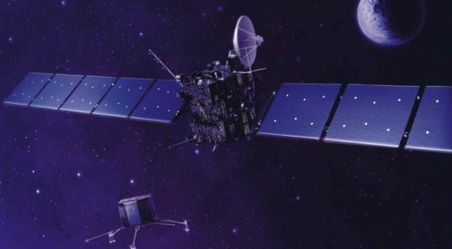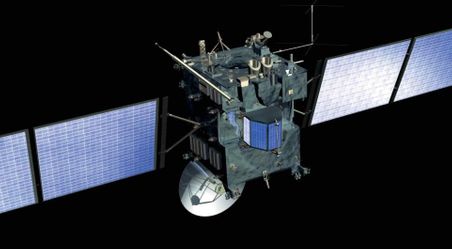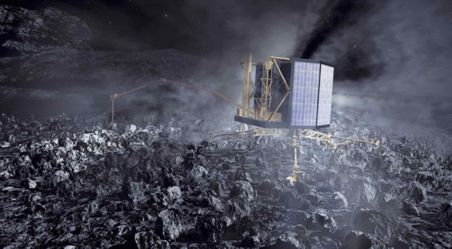Rosetta is an ESA mission to rendezvous with comet 67P/Churyumov-Gerasimenko.
Rosetta

Mission Summary
Comets are the most primitive objects in the Solar System. Their material has remained largely unchanged since they condensed out of the pre-solar nebula 4.5 billion years ago. Rosetta will provide a vital insight into the processes which led to the formation of not only comets, but also the planets, our Sun and the rest of the Solar System.
Rosetta arrived at comet 67P/Churyumov–Gerasimenko (C-G) on 6 August 2014 after a 10-year journey around the solar system. It accompanied C-G along its orbit for just over two years observing its evolution as it became more active while approaching the Sun. The Philae lander detached from the Rosetta spacecraft and landed on the comet's surface on 12 November 2014 to carry out in situ studies of the composition and structure of the nucleus material. The mission ended on 30 September 2016 when the Rosetta spacecraft landed on C-G via "an audacious controlled impact".
Find out more about the story of Rosetta at The Rosetta Homepage at the European Space Agency.
Image above: At the Comet. Image credit: ESA.

Space Magnetometer Laboratory Role
Imperial College is part or the Rosetta Plasma Consortium (RPC), a package of five instruments capable of complementary measurements of the plasma environment around the comet.
Imperial College provided the Plasma Interface Unit (PIU), a common power-management, instrument control and interface unit between the RPC consortioum's sensors and the Rosetta spacecraft.
Imperial College hosts the RPC Operation Centre which manages the consortium's activity and coordinates the operation of the RPC instruments on Rosetta.
Imperial College participation in the Rosetta mission is funded by UK Space Agency (UKSA) and the UK Science & Technology Facilities Council (STFC)
Image above: Orbiter. Image credit: ESA.

Further Information
- Launched: 02-Mar-2004 07:17 UTC
- Mission Ended: 30-Sep-2016 11:19:37 UTC (upon loss of signal following a controlled impact with C-G)
- Orbit: Rosetta trajectory was complex, including three Earth and one Mars gravity assist manoeuvres before finally reaching the comet. On arrival at C-G, Rosetta entered orbit around the comet and stayed with it as it journeyed in towards the Sun and then away from it after perihelion which reached on August 2015.
- Imperial College Involvement: Imperial College is one of the six PI institutes which make up the Rosetta Plasma Consortium (RPC). The Space Magnetometer Laboratory provided the Plasma Interface Unit (PIU). Imperial College manages the operations and coordinates the archiving of the science data products of the RPC.
Rosetta Links:
Image above: Lander. Image credit: ESA.
Useful Links
Rosetta Links: